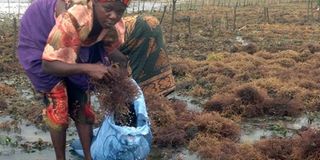Seaweed has a ready market in Europe and Asian nations

Tima Mohamed harvests seaweed at Kibuyuni sea farm next to the Indian Ocean. PHOTO | LABAN WALLOGA | NATION MEDIA GROUP
What you need to know:
- Group makes a living by farming weeds on the shores of the Indian Ocean.
- By end of last year, the seaweed was going for Sh25 a kilo.
From a distance, they look like fishermen at work. But on closer examination, it turns out they are men and women working on ropes and nylon papers that hold some floating plants.
These are the seaweed farmers of Kwale. While many are scrambling for land to cultivate, this group has taken farming to the sea.
And they have chosen the seaweed, a green and brown plant that is suspended on ropes and is spread over a distance at low tides.
Seeds of Gold met 50-year-old Tima Mohammed Usi at her farm in Kibuyuni.
A former small-scale farmer and fishmonger, she is the chairperson of the Kibuyuni Seaweed Farmers Group, which tends to the plant in an area that stretches for more than 150km from Shimoni to Kiromo.
Tima is replanting the sea grass that was unhooked from a nylon rope by waves. During spring tides, she repeats the process on separate lines that form a bloc.
Tima ensures all seeds of the spinosum (Eucheuma denticalatam) and cottoni (Kappaphycus alvarezi) species are tightly tied to prevent them from falling.
She is among the 50 members that acquired knowledge and skills on farming seaweed from the Kenya Marine and Fisheries Research Institute.
“We always had the seaweed in abundance, but we had no use for it.”
A survey by the institute’s researchers in 2010, however, changed the tide.
The group was registered with its first 11 members that pioneered seaweed farming.
Every member was allocated a farm after researchers surveyed the marine area and confirmed it was viable for the project. “The condition for the designated farms was to have areas that remain with water at low tides,” she explains.
Every beginning farmer was also given Sh55,000 grant. To start preparing the farm, Tima explains, a nylon line is laid with two pegs erected that hold 49 seedlings at ago on the seabed. The nylon is fastened to the pegs.
“Some 11 meters of the line is then used to tie the pegs and about 10 meters is fixed with “tie–tie” knots for hanging the seedlings.”
They visit their farms every 14 days to clean and tighten the ropes, replace those washed away and the felled seaweeds.
“Harvesting is simultaneously done by ripping off mature weeds from the tie –tie knots and loaded into canoes. Later, the harvest is spread on sun dried racks for four days.”
And their efforts have already been rewarded with buyers coming from as far away as Tanzania.
Tima says she sold her first harvest in 2010 to Zangue Aqua Farms in Tanzania and made Sh16,640. “This was from a sale of 1,400kg. In 2011, I made Sh14,000.”
In 2012, she sold in three batches, making at total of Sh27,600.
MULTIPLE USES
And the prospects seem to be getting better and better. By end of last year, the seaweed was going for Sh25 a kilo.
Apart from fish feeds, the dried seaweed ‘carrageenan’ extracts are used as homogenisers and thickeners in pharmaceutical, cosmetic and food industry.
They can also be used as a soil conditioner and fertiliser.
Last year, the farmers received Sh60 million from the Kenya Coastal Development Programme to expand their farms.
The market, however, dwindled with increased production. It was only early this month when Sea Weed East Africa came to their rescue. It bought a kilo at Sh30. She made Sh30,000 for a tonne.
The farmers, she says, lose ropes during long rains season when high sea waves push the weeds off shore to the mangrove areas.
This leads to losses as the swept and collected weed cannot be sun dried in wet weather. KMFRI assistant director Betty Nyonje says the best yields are obtained at low temperatures and shallow, calm and constantly warm waters.
“High temperatures and the sedimentation that kills the plants during the North Eastern monsoon winds seasons are another challenge.”
She says researchers are now experimenting at deep sea to mitigate the effects of global warming.
“We realised that the fishermen in these areas lacked resources to venture into deep sea fishing. The alternative was to introduce another means of livelihood,” she says, adding that the project has helped the poor fishing communities of Mkwiro, Funzi and Gazi.
Dr Nyonje says the project was started in Kenya after it succeeded in Tanzania, South East Asia, Philippines and Indonesia.
She adds the seaweed farming project is closely monitored because of environmental concerns and Kenya Plant Health Inspectorate Service (Kephis) has given the institution tight guidelines to adhere to prevent inland and sea invasion.
“We took over a year to quarantine the imported seaweeds after getting a permit to allow the farmers to grow the weeds, which mature in four to six weeks. The vegetative plant can grow to a kilo and after harvest, the farmer needs to pick about 150g for regeneration.”
Ahmed Ali Muktar, the director of Seaweeds East Africa Limited, says they have a ready market in Europe and some countries in Asia.





